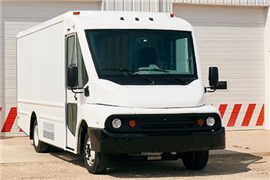Read this article in Français Deutsch Italiano Português Español
Dannar takes it off road for on-site charging
15 December 2024
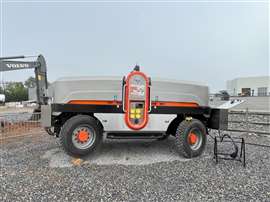 The base vehicle comes with a 250-kWh lithium battery pack, with up to two additional packs available. Shown is the 500-kWh configuration. (Photo: Becky Schultz)
The base vehicle comes with a 250-kWh lithium battery pack, with up to two additional packs available. Shown is the 500-kWh configuration. (Photo: Becky Schultz)
At its Volvo Days customer and dealer event, held at Volvo Construction Equipment’s North American headquarters in Shippensburg, Penn., in mid-September, the company previewed two full-size electric machines: the EC230E Electric excavator and the L120 Electric wheel loader. In introducing these additional – and decidedly more power hungry – electrified models, Volvo acknowledged that to operate such machines efficiently on jobsites, effective charging solutions are a necessity.
As such, the company invited several vendors to display charging options, one of which was Dannar Inc., a Muncie, Ind.-based manufacturer of the Mobile Power Stations (MPS). Dannar displayed a 500-kWh variant of its MPS – a battery-electric, multipurpose, modular platform – “powering” a 23-ton EC230E Electric.
According to Dannar’s Western U.S. Executive Vice President Greg Laudermilch, the MPS features twice the battery capacity of the machine to which it was tethered, plus it is off-road capable, ensuring it can bring that capacity directly to equipment on jobsites.
“It’s essentially similar to the diesel fuel truck or diesel generator equivalent for electrification,” he added.
Charger and ‘generator’ in one
The 22,500-lb. GVW, self-propelled “battery on wheels” measures 178 in. long by 102 in. wide x 98 in. high and has a ground clearance of 15 in. The base vehicle comes with a 250-kWh lithium battery pack, with up to two additional packs available.
“We have a couple different variants, same size footprint, but we can go from 250 kWh up to 500 kWh,” said Laudermilch. “To put that in perspective, most cars are maybe 60 to 100 kWh, so that’s a lot of juice.”
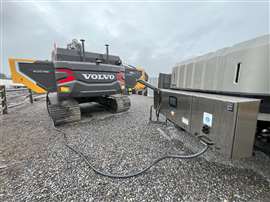 The MPS can be utilized for opportunity charging during lunch hours or breaks, providing up to 120-kW charging on a single CCS1 gun, according to Dannar. (Photo: Becky Schultz)
The MPS can be utilized for opportunity charging during lunch hours or breaks, providing up to 120-kW charging on a single CCS1 gun, according to Dannar. (Photo: Becky Schultz)
The MPS can be charged via a Level 2 charger input or a Level 3 DC fast charger. That power can then be delivered to machines on site in the form of 110 VAC (20A max), 240 VAC (50A max) or Level 2 DC fast charging. In addition, the unit can be optionally configured with 480 three-phase import/export as well as DC fast chargers for power-intensive charging or microgrid applications.
As with a typical on-site charger, the MPS can be utilized for opportunity charging during lunch hours or breaks. The MPS can provide up to 120-kW charging on a single CCS1 gun.
“If you’re in construction or ag, whatever it may be, you want to get back to work making revenue,” Laudermilch said. “The MPS can be used to deliver sufficient charge to enable the machine to finish out a full workday, with the idea to keep the machines running.”
But unlike most chargers that are dedicated to a single task, the MPS can double as a generator. “It can basically do everything that a generator can do, but with faster reaction times,” said Laudermilch. “A typical generator may have some lag if it hits a load. Batteries are much more reactive and can respond to the load faster.
“So, if you have a dewatering job and you don’t want to use your diesel generator, it can basically emulate that. That customer can have one asset instead of multiple assets to do the work that a generator may do.”
When not charging equipment or vehicles, the MPS can also be tied into a microgrid for added energy storage. “Our goal there is how to take an asset and utilize it as much as possible by adding flexibility, whether it’s charging devices, emulating or running as a generator or serving as a battery on a microgrid,” said Laudermilch.
Off-road capabilities
To ensure maneuverability in challenging underfoot conditions, the MPS offers full off-road capabilities, including an oscillating axle and off-road tires. Its rated travel speed is 20 mph.
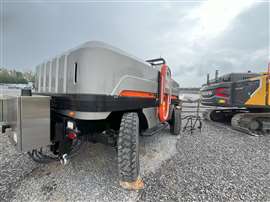 The MPS comes equipped with an oscillating axle and off-road tires for off-road capability. (Photo: Becky Schultz)
The MPS comes equipped with an oscillating axle and off-road tires for off-road capability. (Photo: Becky Schultz)
“The axles oscillate which is not something you traditionally have on a gen-set,” Laudermilch said. “Neither is the ability to traverse up to 24 in. of water – something that has proven beneficial for emergency resilience.”
Other features include traction control and regenerative braking, creep and travel modes and selectable two-wheel, four-wheel coordinated and four-wheel crab steering.
In addition, the MPS comes with a standard 1-mile line-of-sight remote control. “The military will use that,” Laudermilch said. “Obviously, 1-mile line of sight is very important for them to keep personnel out of harm’s way.”
Then there’s the proportional variable displacement electrohydraulic pump rated 42 gpm (max) and 4,000 psi (max). It enables the use of a variety of attachments and accessories.
“The MPS can do a lot of the work of some of these smaller, compact machines,” Laudermilch stated. “We have a variant of that where we put work arms, a snowblower, a sweeper and so much more. Some customers like to be able to go back and forth and have that flexibility.
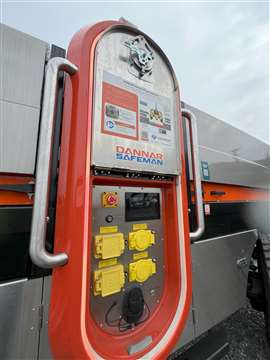 The MPS can provide 110 VAC, 240 VAC or Level 2 DC fast charging. (Photo: Becky Schultz)
The MPS can provide 110 VAC, 240 VAC or Level 2 DC fast charging. (Photo: Becky Schultz)
“And in fact, when it snows at our plant in Muncie, Ind., our team looks out the window and uses the remote control to drive the machine around from inside and sweep the parking lot.”
On top of this is a drawbar pull of up to 100,000 lb., which allows for pulling trailers (with auxiliary brakes) as needed to move equipment and/or materials.
Diverse applications
The MPS has found applications in a number of different markets, including municipalities, military, agriculture, construction, emergency response, and more.
“We continue to find new avenues,” said Laudermilch. “The 500-kWh MPS is also being used to charge electric boats, electric planes, electric drones, both commercially and for other purposes. And so it continues to evolve.
“The market is still maturing, and we’re starting to find more and more use cases every time,” he continued. “We actually say use your imagination, but customers come back with more reasons and ways to use it than we could ever believe.”
POWER SOURCING GUIDE
The trusted reference and buyer’s guide for 83 years
The original “desktop search engine,” guiding nearly 10,000 users in more than 90 countries it is the primary reference for specifications and details on all the components that go into engine systems.
Visit Now
STAY CONNECTED




Receive the information you need when you need it through our world-leading magazines, newsletters and daily briefings.
CONNECT WITH THE TEAM













